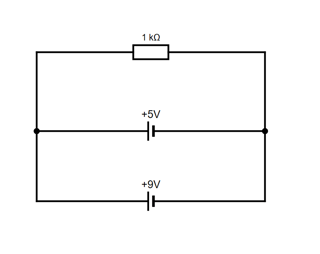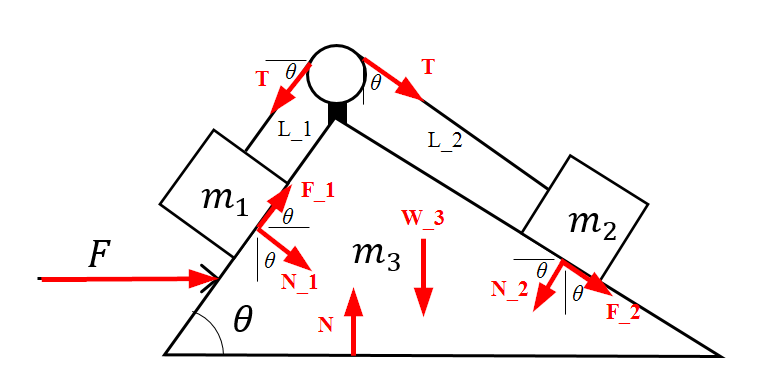I'm going to explain the question by stating a problem.
Homework Problem
Consider this system:
How big horizontal force $F$ should be, so that the mass $m_1$ would be on the verge of slipping upwards? (Friction coefficients between objects is $\mu_s$ but $m_3$ has no friction with the ground. Ropes and the pulley are perfect ie. weightless, frictionless, non-streching).
My Attempt
Firstly I drew important forces:
$m_1$ and $m_2$ are not moving on $m_3$. Therefore all the objects have the same acceleration $a$ which is easily found: $$a_x=\frac{F}{\Sigma m}$$ $$a_y=0$$ Now write equations of motion for $m1$ and $m2$: $$[m_1,x]: T\cos\theta-N_1\sin\theta-{f_s}_1\cos\theta=\frac{F}{\Sigma m}m_1$$ $$[m_1,y]: T\sin\theta+N_1\cos\theta-{f_s}_1\sin\theta-m_1 g = 0$$ $$[m_2,x]: -T\sin\theta+N_2\cos\theta-{f_s}_2\sin\theta=\frac{F}{\Sigma m}m_2$$ $$[m_2,y]: T\cos\theta+N_2\sin\theta+{f_s}_2\cos\theta-m_2 g=0$$ Since $m_1$ is on the verge of slipping upwards, ${f_s}_1=\mu_s N_1$ and re-write equations: $$[m_1,x]: T\cos\theta-N_1\sin\theta-\mu_s N_1\cos\theta=\frac{F}{\Sigma m}m_1$$ $$[m_1,y]: T\sin\theta+N_1\cos\theta-\mu_s N_1\sin\theta-m_1 g = 0$$ $$[m_2,x]: -T\sin\theta+N_2\cos\theta-{f_s}_2\sin\theta=\frac{F}{\Sigma m}m_2$$ $$[m_2,y]: T\cos\theta+N_2\sin\theta+{f_s}_2\cos\theta-m_2 g=0$$ At this point we are left with 4 equations and 5 unknowns ($T$, $N_1$, $N_2$, ${f_s}_2$, $F$).
Now I'm wondering if this is an indeterminate problem or I am missing something? I have thought of finding more equations (elasticity?) but no luck.
I asked two professors to solve this and they could do because they took it for granted that ${f_s}_2=\mu_s N$ which I don't seem to understand why should be necessarily the case. After all my equations do have answers if ${f_s}_2<\mu_s N$ so what stops it from happening? I mean, how does one conclude from $m_1$ being on verge of slipping to $m_2$ experiencing ${f_s}_\max$? And if the argument is wrong, how to solve this problem?
What I think
I think that it has something to do with elasticity. I have realized that sometimes under/over-determinacies are caused by our assumptions:
Example #1 (left): Find internal force in each rod. Under-determinate unless we take elastic deformations into account.
Example #2 (right): Find electric current in the resistor. Over-determinate unless we take internal resistance of batteries into account.
Motivating from these, I tried applying elastic equations:
$$T=-k\Delta l$$
Now, I don't know what to do next. My best guess is that I should stop here and say, $k\Delta l$ could be anything, so the problem is unsolvable unless they tell us the value of initial tension in string. Does this make any sense?
Close Related Problem
Skip this last section. I wanted to edit it out but Sammy's answer already points to this.
When writing this question, another indeterminate problem came into my mind which I found related to this one (not sure tough). This is not my main question. Take this system which is in static equilibrium:
What is ${f_s}_1$ and ${f_s}_2$?
I think we are facing some similar indeterminacy here.









